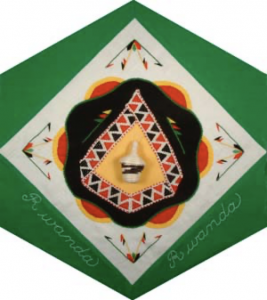Rwanda

The Block
A miniature hand-woven agaseke, contributed by Félicité Murangira, sits prominently in the centre of this block. Such baskets, which feature distinctive conical tops, are made from papyrus and sisal fibres and have become a national symbol of Rwanda. Made in a variety of sizes, they are used to carry a wide assortment of goods, from salt to millet to sorghum. For generations they have also been used to hold gifts to newlyweds and new mothers, representing the endurance of family values.
Today the art of basketry, which dates back centuries, has turned into a source of income for many Rwandan women. It has also become a means of reconciliation for Rwandan families torn apart by ethnic conflict. A band of beadwork (similar to headbands worn by tribe members) frames the basket, which sits atop a montage of appliquéd fabrics outlined in embroidery. The triangle pattern in the band––a basic geometric shape used in beadwork––is said to represent the family: one point each for mother, father and child. The corner designs, typically found on household linens, feature traditional hues found on brightly coloured robes worn throughout the country.
Cultural Profile
Rwanda is a small landlocked country in the heart of east-central Africa. Formerly a part of German East Africa, later under Belgian rule, Rwanda was once joint with its neighbour Burundi in the country of Ruanda-Urundi. The nation’s predominately mountainous terrain, which has earned it the nickname “The Land of a Thousand Hills”, is made up in part by the volcanic Virunga range, which includes Volcan Karisimbi, Rwanda’s highest peak. Volcanoes National Park is home to half the world’s remaining mountain gorillas. These apes were once studied by American zoologist Dian Fossey who is buried in the country under a stone marked Nyiramacilibi, which means”the lone woman of the forest”. Rwanda is a tiny country but is also one of Africa’s most densely populated nations. More than 80 percent of its inhabitants are Hutu; the remainder are Tutsi, with a small group of Twa (Pygmies). The official languages are Kinyanwanda, French and English, although Swahili is also spoken.
Family life is central to Rwandan society. Most of the predominantly rural population––engaged mainly in subsistence agriculture––live on a rugo, a traditional homestead consisting of several beehive-shaped houses within a larger, fenced compound. The most important crops are the matoke, the green bananas which are a staple food in Rwanda, potatoes, beans, coffee and tea, which are well adapted to the rich volcanic soil of the country.
The country’s rich culture is evident in the many beautiful crafts produced, including Twa pottery, painting, jewelry making and metal work. A unique art form is imigongo, wall murals that are made by women using cow dung mixed with soil. The mixture is spread onto walls following geometric patterns and then red, white, black and blue pastes are applied. Men create woodcarvings, pipes, stools, knife handles, gourd containers, and ingoma, or drums, which are very important in Rwandan music. Other traditional instruments include the lulunga, similar to a harp, and mbira or kalimba, the thumb-piano. Oral traditions of proverbs, songs and chants are cherished by all ethnic groups, and public speakers and storytellers are honoured. The country’s strong tradition of folklore includes many stories once used to teach values, or to tell the tales of national heroes.
In the early 1990s, sizable numbers of Rwandans came to Canada as refugees fleeing the civil war ravaging their homeland. Many settled in Québec because of their proficiency in French. The 2011 census reports over 8,000 Rwandans now living in this country.
Sponsor: Carol and Jasmin Paschek
